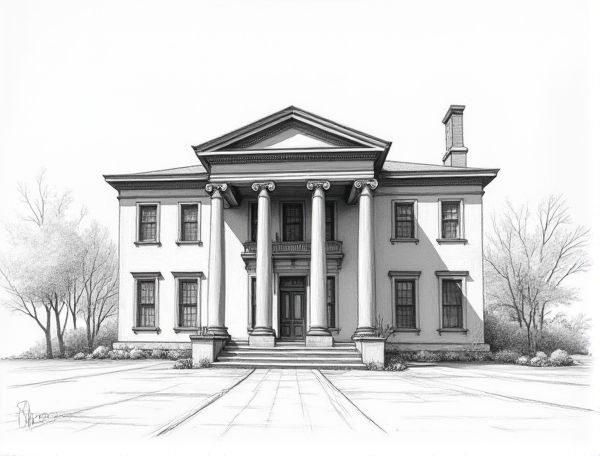
Photo illustration: Greek Revival home design with structural entablature detailing
Greek Revival home design features bold structural entablature detailing that emphasizes classic proportions and intricate moldings, enhancing your home's architectural elegance. Discover how these timeless elements can transform your living space by reading more in the article.
Introduction to Greek Revival Home Design
Greek Revival home design emphasizes symmetrical shapes, bold moldings, and iconic columns inspired by classical Greek temples, integrating pediments and heavy cornices to create a stately, timeless aesthetic. Popular in the United States during the early 19th century, this architectural style highlights white-painted exteriors mimicking marble and large porches supported by Doric or Ionic columns, reflecting democratic ideals and classical beauty.
Historical Roots of Greek Revival Architecture
Greek Revival architecture draws inspiration from ancient Greece, emphasizing symmetrical shapes, tall columns, and pediments that reflect classical temples. You can incorporate these timeless elements to add elegance and historical significance to your home design.
Key Characteristics of Greek Revival Homes
Greek Revival homes feature symmetrical facades, tall columns resembling classical Greek temples, and bold pediments that emphasize a grand entrance. These structures often incorporate heavy cornices, wide friezes, and elaborate doorways with transom windows, reflecting the elegance of ancient Greek architecture. Your home design benefits from these timeless elements by combining stately proportions with refined decorative details, creating an impressive yet welcoming aesthetic.
Understanding Structural Entablature in Greek Revival
Structural entablature in Greek Revival architecture consists of the architrave, frieze, and cornice, serving both decorative and load-bearing functions atop columns. This design element creates a harmonious transition between vertical supports and the roofline, emphasizing classical proportions and symmetry essential to the style.
Components of Greek Revival Entablature Detailing
Greek Revival entablature detailing features a prominent cornice with dentil molding and bold, symmetrical lines reflecting classical antiquity. The frieze typically remains plain or displays triglyphs and metopes, enhancing the structure's stately appearance. Supporting the entablature, the architrave consists of horizontal bands that emphasize proportion and balance in Greek Revival architecture.
Materials and Finishes for Authentic Greek Revival
Authentic Greek Revival home design emphasizes materials like smooth marble, limestone, and stucco to replicate classical elegance. Finishes often include white or off-white paint to highlight architectural details paired with natural wood accents in oak or mahogany. Incorporating refined plaster moldings and matte, muted tones enhances the timeless, historic character of the style.
Integrating Columns and Entablature for Visual Impact
Integrating columns and entablature enhances your home's architectural appeal by adding depth and classical elegance to any space. Proper alignment and proportion between columns and the entablature ensure a balanced visual impact while reinforcing structural integrity. Strategic placement around entryways or living areas can create focal points that elevate your design's sophistication.
Modern Interpretations of Greek Revival Detailing
Modern interpretations of Greek Revival detailing emphasize clean lines, minimalist moldings, and the use of sustainable materials to create a contemporary yet timeless aesthetic. Incorporating elements such as simplified Doric columns, understated pediments, and subtle cornice profiles enhances architectural character while maintaining a sleek, modern appeal. These design choices blend classical grandeur with functional elegance, making Greek Revival motifs relevant in today's home design.
Tips for Restoring Greek Revival Entablature Elements
When restoring Greek Revival entablature elements, carefully assess the condition of the cornice, frieze, and architrave to identify areas needing repair or replacement. Use historically accurate materials such as wood or composite that mimic the original craftsmanship, preserving the architectural integrity of your home. Your attention to detail in matching profiles and preserving decorative moldings ensures a seamless restoration that honors the classical style.
Enhancing Curb Appeal with Greek Revival Features
Incorporating Greek Revival features such as tall columns, pediments, and symmetrical facades significantly enhances curb appeal by evoking classical elegance and timeless architectural beauty. These elements create a grand entrance that boosts property value and makes a striking first impression in residential neighborhoods.
 homedesy.com
homedesy.com